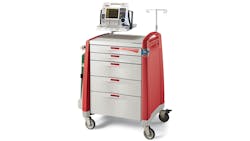One of the hallmarks of stock car racing during the days of yore – way back in the mid-20th century – was a simple premise: “Race on Sunday – Sell on Monday.” Another version was “what wins on Sunday sells on Monday.”
The idea behind the mantras was simple. When Lee Petty won the inaugural Daytona 500 in 1959, driving his No. 42 Oldsmobile Super 88, fans the next day could storm the Oldsmobile dealerships to pick out a version of the same car Petty drove so well. In short, because cars were stock they largely were commodities.
Some affix that classification to mobile and stationary carts used for storing products – be they exchange carts, PAR carts, open and closed automated storage cabinets or any number of clinically dedicated storage vehicles.
Clinicians and administrators readily can take for granted these fundamental tools used for storage and tracking. Are they akin to kitchen cabinets (differentiated by interior design preferences) or mobile tool cabinets in mechanics’ and pit crew garages (differentiated by access convenience and utility)?
In the high-demand, high-traffic areas of the hospital, not unlike that of a pit crew garage during the big race, access convenience to product and ease of utility remain paramount – certainly when clinicians need something in a pinch or an emergency.
How do you engender respect for the skeleton of a clinical supply chain operation? How might you improve on something so pivotal to patient care delivery? Add electronics (including waist belt-worn/pocket sensors?) for remote control mobility? Install configurable pull-out shelves for convenient loading? Larger cubbies and spaces? More custom-configurable options? Corrosion-protection/rust-proofing? Hydraulics? Hot Wheels-style casters?
These may be viable options to consider as you contemplate the vroomy goodness of carts available now as well as how you might “resto-mod” or redesign any useful element of your preferred cart for the future.
What do customers want?
To generate sales and success product manufacturers, by and large, need to have their fingers on the pulse of customer demands – both current and potential with an eye to what’s emerging.
For Claudia Tuttle, Marketing Manager, Accuride International, the overarching theme is obvious: “Future-proof design.
“Every generation of cart – or any piece of hardware for that matter – is more technologically complex and more informationally connected than the previous one,” Tuttle noted. “Those attributes mean greater cost and, thus, greater investment from manufacturer and customer alike. A next-generation medical cart must have a forward-thinking design to make the most of investments by manufacturer and customer alike.”
Tuttle emphasizes four elements of preferred design:
- Understands practicality
- Maximizes versatility
- Addresses security and accountability
- And uses modular elements for quick future upgrades
“A couple of these sound obvious, but you would be surprised how many manufacturers overlook something like practicality,” Tuttle observed. “For example, far too many medical carts have drawers that roll out as the carts are pushed around. That’s just a nuisance, you might think. Sure, it’s a nuisance [until] that opened drawer strikes a patient, or prescription narcotics fall out and into the hands of passersby. These things happen, but they don’t have to. Simply using ball bearing slides with heavy-duty hold-in strength will keep compartments closed.”
“Historically, supply inventory management has consisted of secure cabinets that are very stationary,” Russell indicated. “And while security is a critical attribute, as we look ahead to the mobile supply cart of the future, workflow flexibility and mobility may be of more importance.
“In general, our acute care facilities are looking for supply automation with more accessible, open storage solutions,” she continued. “Supply inventory optimization solutions that are mobile can help maintain flexibility; particularly with items that may be low value, but still need to be managed to ultimately save money and allow caretakers to interact more with their patients. Mobility can be incredibly beneficial for the end user.”
“Storage flexibility seems to be the most important attribute for cart storage today,” Miller noted. “Customers want to pack as many supplies and equipment onto or into their cart as possible, so they need flexible and efficient storage options as well as the ability to accept multiple accessories so their cart is configured exactly the way they want.”
Ease of use matters heavily, emphasizes Chris Stegura, Business Development Manager, Quantum Medical.
“Ease of use will always be at the forefront,” he said. “That cart may take on a variety of forms based on the way it is being used and the functions it is being used for. Because of the variety of needs a hospital has, the perfect cart may exist five different ways and have five different looks because each area using the cart has different needs.”
Automation and interoperability will offer desired convenience, too, according to Russell.
“In addition, layering in a Radiofrequency Identification (RFID) component to carts has the potential to provide additional convenience for clinicians and provides the opportunity for their workflow to remain in line with their normal care practices. This also allows information to be easily shared with the supply chain to ensure they’re delivering the right product on time for the clinicians to best serve the patient,” she said.
“This all connects to a popular trend in healthcare today: Interoperability,” Russell noted. “Connecting solutions, including carts, can optimize effective supply chain management and help to achieve the goals of safe, efficient and cost-effective practices across the health system. Providers are interested in data-driven insights that help clinicians move between products more naturally, while improving workflows and providing alternate ways to capture patient, medication, billing and supply information, with the ultimate goal of producing the best outcomes for the patient.”
“Reliability. It just needs to work how it is specified to work without failure,” he said.
“At its foundation, storage carts have a simple job: Organize and store supplies, lock, and unlock,” Grabowski continued. “When used, they need to open quickly to allow healthcare providers access to what they need to provide patient care. When not in use, secure the inventory of the cart.
“It doesn’t matter what color the cart is, or if it features a breakaway seal lock, simple key lock or sophisticated electronic lock,” he insisted. “If a clinician can’t get the drawer open, we have failed the clinician and the patient. Healthcare providers have a tough job. Every minute they have to spend wrestling with a jammed drawer or finnicky lock is less time they have for care with their patients. This is even more important with Emergency Carts as those few seconds may be the difference between life and death. For storage carts, the old adage, ‘you get what you pay for’ holds very true. If you have ever pulled the drawer open on an inexpensive or basic cart, you can feel it. You know it’s not going to last or be reliable down the road.”
“Time is everything, and how a department saves time is better organization of the goods being used so the primary objective for a storage system or cart is optimizing a department’s organization of supplies,” Loper told Healthcare Purchasing News. “An organized cart will enable the staff to quickly find the supplies when needed. Time is money as the saying goes, but more importantly, time within a healthcare setting is enhanced patient care, and in some cases time savings could lead to saving lives. An organized cart will save the hospital space as well, which leads to better organization and work flow. When a cart is configured to be highly space efficient, the bi-product of space savings is quicker retrieval of supplies. Optimizing space equals elevated levels of organization, enhanced work flow, quicker retrieval and ultimately, better patient care.”
The secret to optimization is space efficiency, according to Loper, which he links to a well-known video game.
“Think Tetris. When compartments within each linear shelf space is cubically maximized, whether it’s a traditional wire cart with plastic bins or a high-density basket system, there will be no wasted space, which translates into more supplies within a smaller footprint, assuming the PAR levels have been paired down and are optimal to fulfill operations between replenishment,” Loper explained.
He cites this example with a domino effect: “By consolidating two carts into one cart, space will be recovered. When space is recovered, the nursing staff will need to move their body less by walking less and search less, freeing up time. Instead of supplies being stored in two different rooms they can store the supplies in one room. Instead of supplies being stored in 2,000 square feet, the supplies can be consolidated into 1,000 square feet, reducing the walk time of covering the extra 1,000 square feet, which adds up on a per pick/put-away basis.”
“Safety is paramount to our customers,” Hom noted. “The Omnicell XT Automated Dispensing Systems (ADS) feature metal locking drawers and single-dose dispensing for added medication safety and security. The XT systems’ biometric authentication for entry also adds to the security of the automated dispensing systems, limiting access to medications based on the clinician’s role within the health system. It’s very important that medications are secure in an environment of drug shortages and diversion. Medications need to be available for proper patient medication therapy.” Hom further noted that Omnicell no longer develops mobile carts for medication administration as its Savvy Mobile Medication System “became End of Life in 2017.”
What to deliver?
Knowing or anticipating what customers want may be half the battle as manufacturers then have to respond with providing the right products or services to satisfy those demands. Yet that means being able to forecast ways to improve carts in the areas of design, functionality, structure or utility.
During this decade, cart manufacturer experts believe they have it covered.
“Without a doubt, I would make electronic access control (EAC) an essential part of cart design,” assured Accuride’s Tuttle. “Medical carts carry sensitive contents: Medications, medical records and special equipment. These carts must combine the security of those contents with quick accessibility so as not to stifle operations. EAC systems make this combination possible.
“In the case of [Accuride’s] Senseon One, you have compact, yet robust, electronic locks integrated onto ball bearing slides,” Tuttle continued. “These locks serve as part of a seamless and modular system built within the cart. A swipe or tap of an RFID card (or access tool of choice) means authorized staff can unlock and open a compartment quickly.
“But modern, cart-level EAC, like Senseon Plus, can go further than that. A system manager can determine who can access what with an audit trail for accountability and operational data insights. Cloud-based audit software underpin these systems, allowing managers to access that information anytime and from anywhere. A manager can even set up auto-relock to activate after a certain length of time to ensure a compartment is secured in case staff forget,” Tuttle added.
Capsa Healthcare’s Grabowski embraces secure interoperability as the utilitarian driving force.
“One improvement would be to align the use of technology to synchronize the medical support equipment across users and different areas of care,” he said. “Make access easier, but with greater accountability. There are plenty of solutions out there to utilize individual user codes or proximity cards with basic reports of user access. They seem to work great right after implementation, but maintaining credentials and user groups becomes complicated, and access and/or reliability may become an issue. Managing the user database becomes even more difficult with contract staff and frequent personnel changes. This can become a barrier to optimizing the proper application of storage carts. Features like this may also add to the IT department’s workload.”
Within the next decade carts most likely will have to “plug in” to the organization, according to Grabowski.
“As the Internet of Things continues to develop, storage carts will work in conjunction with the hospital security systems instead of a standalone department application,” he predicted. “Facilities will only need to complete one New User Registration instead of multiple ones in multiple systems. When a new nurse starts, his or her ID Badge will have the right level of access for everything they need to perform their duties – access to computer applications, electronic health records, entry doors, automated medication dispensing cabinets and storage carts. Facilities can use this information to analyze and better understand movement and position of both personnel and capital assets in order to improve their workflows and level of patient care.”
Quantum Medical’s Stegura concurs.
“I think having all carts being WiFi-enabled to be able to integrate it with an inventory system throughout the hospital – not just in certain rooms – is where things are going to move towards, possibly sooner rather than later,” he said.
One extension of flexibility is customizable modularity, observed InterMetro’s Miller.
“A modular, customizable accessory mounting system with optional integrated power delivery would be an ideal improvement,” he said. “This would allow customers to easily add standard as well as custom accessories, and also be able to power computers, scanners, monitors, diagnostic equipment, etc. without wires getting in the way.”
Omnicell continually strives to advance the XT Series ADS technology to make it more patient-centric, Hom insists.
“In the next decade, enhanced data intelligence will be one of the most important functionality improvements for our customers – analytics that provide actionable insights to better understand medication usage and improve pharmacy supply chain management,” Hom said. “The XT ADS is integrated with Omnicell’s Intelligence solution, Omnicell One, to utilize the rich data that is generated from the automation.
“Today, all Omnicell systems together currently monitor over 400TB of data, and 75 million integration messages between systems, specific to medication management,” he continued. “This is going to continue to grow and become more complex in the future. The ability to leverage all of this data to achieve greater insight into an organization’s medication and clinical needs and to recommend and deliver [actionable] workflow improvements will greatly enhance the efficiency and safety of pharmacy operations.”
Yet what if … carts didn’t exist anymore? DSI’s Loper takes possibilities to another level.
“In a perfect world scenario 10 years from now, all carts will be become obsolete,” Loper posited. “Supplies will be immediately in the hands of the nurse seconds before the products are being used on the patient. Will this require magic? Is it a just-in-time (JIT) storage system? How we get there, I don’t know. The products on the market today have not changed much over the course of the last decade, so I wouldn’t forecast anything game-changing in the future.
“But what has changed are the processes,” he continued. “Process and system methodologies, such as Lean, 2-bin Kanban, 5-S, Six Sigma, Tear-Free, Value Stream Analysis, are all process changes that Supply Chain, SPD and OR employees have adopted throughout their daily operations. Actual storage cart innovations, functionality and features have not evolved. There have been some incremental improvements and small innovations along the way with RFID, Scope Cabinets, High-Density Instrument Set Storage, etc., but nothing ground-breaking. Is this a market prime for innovation and disruption? Yes, but the market has yet to witness a needle-moving product that changes the way the game has been played for the previous 10 years [and] that doesn’t mean history repeats itself in the world of healthcare storage equipment.”
Short of magic, Loper doesn’t believe “supply-on-demand” capabilities through 3-D printing of sterile and non-sterile products are feasible.
“I’m not sure of the benefits of 3-D printing, etc., but implementing Lean processes throughout a department is mission critical,” he insisted. “Knowing the two biggest costs in a hospital are the employees and the inventory in the building, process changes like Lean and 2-bin Kanban can have a huge fundamental impact on a department’s overall operating cost with the intent to help drive costs down. Efficient storage equipment is a part of the process improvement that plays into the equation. Efficient space-saving carts backed by any sort of brains and/or software technology behind it are very expensive, hard to justify the investment, and are barely in the proof-of-concept stage as we’ve noticed with RFID concepts. If the inventory is high in value, it’s easier to justify the investment into a smart cart to help manage and secure the expensive inventory, but on a per-cart basis it’s much more cost-effective to store less-expensive disposables in a less-expensive cart and vice versa.”
References
1. Work, Mitch. “Automating the OR supply chain at Memorial Hermann Healthcare System.” Healthcare financial management: journal of the Healthcare Financial Management Association vol. 64,10 (2010): 100-4.
2. Roper, Kathy O., Arya Sedehi, and Baabak Ashuri. “A Cost-Benefit Case for RFID Implementation in Hospitals: Adapting to Industry Reform.” Facilities 33, no. 5/6 (2015): 367–88. https://doi.org/10.1108/f-05-2013-0041.
Taking a peek at ‘concept cart’ ideas
Healthcare Purchasing News asked a handful of cart manufacturer executives to predict how carts for storage – by 2030 – might function, look and be used differently? Here’s what the experts shared.
“Just as autonomy and automation are playing a bigger role in transportation, I see autonomy and automation going hand-in-hand with the medical carts of tomorrow. I see autonomous carts delivering medications to patients on a schedule and a pre-planned route within a facility. People will remain in a managerial role, programming those routes and which medications go to which patients.
“Electronic access control systems will be crucial. These systems will track sensitive contents, such as prescription narcotics, at every stage of their journey. That means you’ll have a data trail from the first delivery of those contents to their storage, retrieval by staff, and administering to patients. This would result in automatic compliance with industry standards and requirements.
“The most routine and repetitive tasks become automated. What’s great about this is that it frees up human personnel to focus on more personalized care for patients.”
Claudia Tuttle, Accuride International
“By 2030, it is reasonable to believe that storage carts and automated dispensing cabinets will begin to blend into one unit. Healthcare systems are continually looking to cut costs and eliminate waste. Medications have a much higher unit cost, so it is easier to achieve return-on-investment by gaining better inventory control of meds first. As the technology continues to improve, it will make it easier to control the supplies as well. Carts will work more effectively than simply granting access via ID badge or biometric credentialing. They will record that a medication or supply item has been removed without users having to actively log each item that was taken. The carts may then automatically generate reports to help ensure PAR levels are maintained. Inventory checks, resupply and audits for use and billing will be wholly automated. With each cart reporting on its inventory, Supply Chain gains a greater understanding of the facility’s overall inventory and how and where it is being used. This will allow adjustments to the needs of each cart in each unit, minimize the losses associated with expiring stock and remove unnecessary or less common items to lower overall cost.
“It’s also possible we will see storage carts become more versatile [by] combining storage, computer, and medical devices. It is likely computer and medical devices will continue to become smaller and more efficient. There are situations today where you may see clinicians pushing a cart and pulling another device behind them. In the future, storage carts may offer more versatile power options and more versatile integration with medical devices and accessories, streamlining the care delivery process into one cart workstation.
“Looking forward to 2030, with an aging clinical staff, an aging Baby Boomer population and greater focus on workflows and asset management, it’s feasible to foresee a move toward automated robotic storage carts that come to the clinical procedure on demand. This sounds fun, and technology is great but the human factor is what truly makes the difference in the care delivery process. Imagine that a better patient experience starts with the clinician entering the room without a storage cart or related technology and calmly engages the patient. Once the patient feels comfortable, the cart automatically moves into the room, and the patient care experience continues pleasantly, and without interruption.”
Joe Grabowski, Capsa Healthcare
“Omnicell’s XT ADS’ are expanding beyond a single point solution. Omnicell is now developing and implementing a platform of products and services that support the autonomous pharmacy – a roadmap designed to develop a zero-error, fully-automated medication management infrastructure that integrates a comprehensive set of solutions – including automation, intelligence and expert services, powered by a cloud data platform – to support improved efficiency, regulatory compliance, and patient outcomes.
“As part of the larger autonomous pharmacy roadmap, Omnicell XT ADS’ are often the data-rich automation foundation that helps clinicians deliver the safest, most efficient care possible. Clinicians will leverage data from the XT ADS solutions to optimize inventory, identify potential diversion, and gain access to actionable insights that enhance pharmacy performance.”
Len Hom, Omnicell Inc.
“By 2030, miniaturized electronics can be more highly integrated into storage carts that would allow faster and more efficient inventory management, charge capture and security access measures. The importance of patient-caretaker interaction will drive more automation to reduce the administrative burden on caretakers.”
Scott Miller, InterMetro Industries
“Carts are always going to evolve and change, but the basic form and function will stay close to where it is now, but have better bells and whistles. We work very closely with our customers to stay on top of the changing needs they have and have products that fill those needs. Lighter, stronger materials will emerge, but carts will adapt to the items/materials they are carrying and the functions they are being used for in a facility.”
Chris Stegura, Quantum Medical
About the Author
Rick Dana Barlow
Senior Editor
Rick Dana Barlow is Senior Editor for Healthcare Purchasing News, an Endeavor Business Media publication. He can be reached at [email protected].






